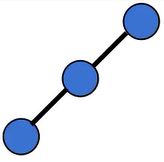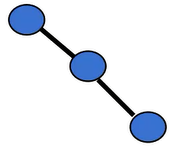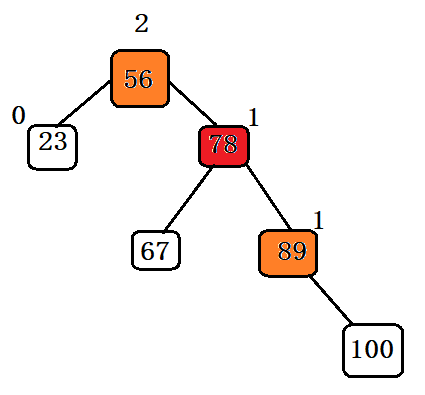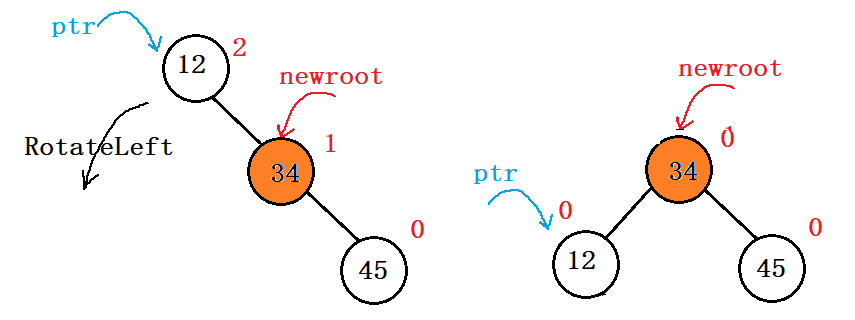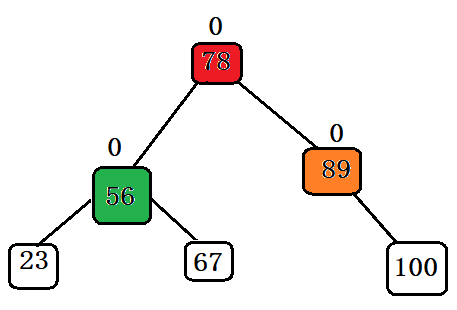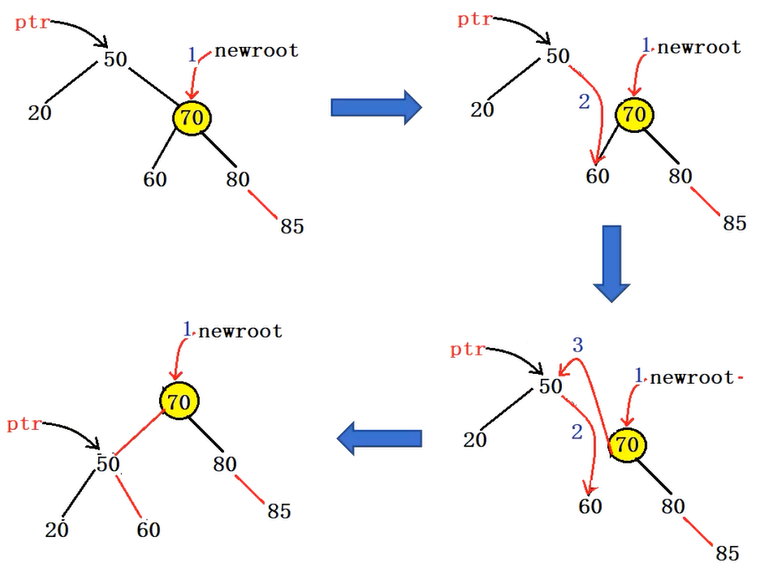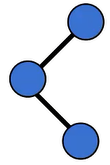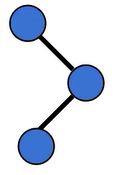AVL - 平衡搜索树
单旋转
双旋转
在计算机科学中,AVL树(以发明者Adelson-Velsky和Landis 命名)是一种自平衡-二叉搜索树(BST) 。在AVL树中,任何节点的两个子树的高度最多相差1;如果在任何时候它们的差异超过1,则会进行重新平衡以恢复此属性。在平均情况和最坏情况下,查找、插入和删除都需要O ( log n ) O(\log n) O ( log n ) n n n
AVL树以其两位苏联发明家Georgy Adelson-Velsky和Evgenii Landis的名字命名;
AVL树经常与红黑树进行比较,因为它们都支持相同的操作集并且采用O ( log n ) O(\log n) O ( log n )
可以看到, 相比于二叉搜索树只多出一个balance因子, 这个平衡因子将带来什么魔力呢?
1 2 3 4 5 6 7 8 9 typedef int KeyType;typedef struct AVLNode { struct AVLNode * leftchild; struct AVLNode * parent; struct AVLNode * rightchild; KeyType key; int balance; }AVLNode, *AVLTree;
如果在一棵平衡的二叉搜索树中插入一个新节点,造成了不平衡。此时必须调整树的结构,使之平衡化。
平衡化旋转有两类:
单旋转(左旋和右旋)
双旋转(左平衡和右平衡)
每插入一个新节点时,AVL树中相关节点的平衡状态会发生改变。因此,在插入一个新节点后,需要从插入位置沿通向根的路径回溯,检查各结点的平衡因子(左、右子树的高度差)。
如果在某一节点发现高度不平衡,停止回溯。
从发生不平衡的节点起,沿刚才回溯的路径取直接下两层的节点。
如果这三个节点处于一条直线上,则采用单旋转进行平衡化。单旋转可按其方向分为左单旋转和右单旋转,其中一个是另一个的镜像,其方向与不平衡的形状相关。
如果这三个节点处于一条折线上,则采用双旋转进行平衡化。双旋转分为先左后右和先右后左两类。
要达到平衡需要的旋转操作
例子
原因
右单旋转(顺时针)
左孩子的左子树高 - 左左旋转
左单旋转(逆时针)
右孩子的右子树高 - 右右旋转
此图为例,插入100后,56的平衡因子为2,78为1,89为1。则我们需要以78为轴,将56进行左单旋转。
左单旋转会是什么效果?先看简单的情况
以此为启发,进行旋转
再来看一个与代码步骤有关的图例
newroot指针指向ptr的右子树(轴)
ptr的右孩子指针指向newroot的左子树(承)
newroot的左孩子指针指向ptr(揽)
以下为最基本的三步走:
1 2 3 4 5 6 void RotateLeft (AVLTree& tree, AVLNode* ptr) AVLNode* newroot = ptr->rightchild; ptr->rightchild = newroot->leftchild; newroot->leftchild = ptr; }
在这三步中,每一步的后面都要做相应的对parent的维护
newroot的父指针指向ptr的父节点(ptr的父节点代替了newroot的父)
若newroot有左孩子,则左孩子的父指针指向ptr的节点
ptr的父指针指向newroot
1 2 3 4 5 6 7 8 9 10 11 void RotateLeft (AVLTree& tree, AVLNode* ptr) AVLNode* newroot = ptr->rightchild; newroot->parent = ptr->parent ptr->rightchild = newroot->leftchild; if (newroot->left != nullptr )newroot->leftchild->parent = ptr; newroot->leftchild = ptr; ptr->parent = newroot; }
在最后一步,处理ptr的parent指针之前,还要处理ptr的父节点的某一孩子指针 指向问题,原本是指向50的(即ptr) ,但70(newroot)包揽了50(ptr)的地位,则原本50(ptr)的父节点的一个孩子指针就要指向70(newroot),至于是左孩子指针还是右孩子指针,需要根据是否和ptr地址是否相等判断 。
1 2 3 4 5 6 7 8 9 10 11 12 13 14 15 16 void RotateLeft (AVLTree& tree, AVLNode* ptr) AVLNode* newroot = ptr->rightchild; newroot->parent = ptr->parent; ptr->rightchild = newroot->leftchild; if (newroot->left != nullptr )newroot->leftchild->parent = ptr; newroot->leftchild = ptr; if (ptr->parent->leftchild == ptr)ptr->parent->leftchild = newroot; else ptr->parent->rightchild = newroot; ptr->parent = newroot; }
代码还没完,还要处理根节点的变化
1 2 3 4 5 6 7 8 9 10 11 12 13 14 15 16 17 18 19 void RotateLeft (AVLTree& tree, AVLNode* ptr) AVLNode* newroot = ptr->rightchild; newroot->parent = ptr->parent; ptr->rightchild = newroot->leftchild; if (newroot->left != nullptr )newroot->leftchild->parent = ptr; newroot->leftchild = ptr; if (ptr == tree)tree = newroot; else { if (ptr->parent->leftchild == ptr)ptr->parent->leftchild = newroot; else ptr->parent->rightchild = newroot; } ptr->parent = newroot; }
旋转方向
例子
原因
左右双旋转
左孩子的右子树高
右左双旋转
右孩子的左子树高
先以左孩子节点为根节点, 左孩子节点的右孩子节点为轴, 进行左单旋转;
再, 以父节点为根节点, 左孩子节点为轴, 进行右单旋转;
在向一棵本来是高度平衡( b a l a n c e = 0 , 1 , − 1 ) (balance = 0,1,-1) ( b a l a n c e = 0 , 1 , − 1 ) ∣ b a l a n c e ∣ > 1 |balance| > 1 ∣ b a l a n c e ∣ > 1
1 2 3 4 5 6 7 8 9 10 11 12 13 14 15 16 17 18 19 20 21 22 23 24 25 26 27 28 29 30 31 32 33 34 35 36 37 38 39 40 AVLNode * Buynode (KeyType kx) AVLNode * s = (AVLNode*)malloc (sizeof (AVLNode)); if (nullptr == s) exit (1 ); memset (s, 0 , sizeof (AVLNode)); s->key = kx; s->balance = 0 ; return s; } bool Insert (AVLNode *& tree, KeyType kx) if (tree == nullptr ) { tree = MakeRoot (val); return true ; } AVLNode * pa = nullptr ; AVLNode * p = tree; while (p != nullptr && p->key != kx) { pa = p; p = kx < p->key ? p->leftchild : p->rightchild; } if (p != nullptr && p->key == kx) return false ; p = Buynode (kx); p->parent = pa; if (kx < pa->key) { pa->leftchild = p; } else { pa->rightchild = p; } return true ; }
对于AVL树来说, 单纯的Insert是不够的, 还需要依靠四个函数 - 左旋/右旋/左右旋转/右左旋转, 来达到对树结构的平衡化;
需要考虑的一个关键点: 回溯的终止条件是什么? 即for循环终止判断语句;
1 2 3 4 5 6 7 8 9 10 11 12 13 14 15 16 17 18 19 20 21 22 23 24 25 26 27 28 29 30 void PassBalance (AVLNode &tree, AVLNode * ptr) AVLNode * pa = p->parent; for (; pa != nullptr ; ) { if (pa->leftchild == p) switch (pa->balance) { case 0 : pa->balance = -1 ; break ; case 1 : pa->balance = 0 ; break ; case -1 : LeftBalance (tree, pa);break ; } else switch (pa->balance) { case 0 : pa->balance = 1 ; break ; case -1 : pa->balance = 0 ; break ; case 1 : RightBalance (tree, pa);break ; } p = pa; pa = p->parent; } }
还可以进一步做优化: 循环不一定要一直继续 - 有可能节点在插入之后, 整个树的高度没有发生变化, 此时无需进行全部的回溯;
1 2 3 4 5 6 7 8 9 10 11 12 13 14 15 16 17 18 19 20 21 22 23 24 25 26 27 28 29 30 31 32 33 34 35 void PassBalance (AVLNode &tree, AVLNode * ptr) AVLNode * pa = p->parent; bool taller = true ; for (; pa != nullptr && taller; ) { if (pa->leftchild == p) switch (pa->balance) { case 0 : pa->balance = -1 ; break ; case 1 : pa->balance = 0 ; taller = false ; break ; case -1 : LeftBalance (tree, pa); taller = false ; break ; } else switch (pa->balance) { case 0 : pa->balance = 1 ; break ; case -1 : pa->balance = 0 ; taller = false ; break ; case 1 : RightBalance (tree, pa); taller = false ; break ; } p = pa; pa = p->parent; } }
这样一来, 此循环最多进入两次即可退出, 因为, 不管你把pa->balance调为-1或1, 下次循环中的pa->balance肯定不会是上次的值, 而某一case中, 除了第一种情况taller为true, 其他两种均为false;
1 2 3 4 5 6 7 8 9 10 11 12 13 14 15 16 17 18 19 20 21 22 23 24 25 26 27 28 29 30 31 32 33 void LeftBalance (AVLTree & tree, AVLNode * ptr) AVLNode * leftsub = ptr->leftchild; AVLNode * rightsub = nullptr ; switch (leftsub->balance) { case 0 : break ; case -1 : RotateLeft (tree, ptr); ptr->balance = 0 ; leftsub->balance = 0 ; break ; case 1 : rightsub = leftsub->rightchild; switch (rightsub->balance) { case -1 : leftsub->balance = 0 ; ptr->balance = 1 ; break ; case 1 : leftsub->balance = -1 ; ptr->balance = 0 ; break ; case 0 : leftsub->balance = 0 ; ptr->balance = 0 ; break ; } RotateLeft (tree, leftsub); RotateRight (tree, ptr); rightsub->balance = 0 ; break ; } }
如果被删结点x最多只有一个孩子,那么问题比较简单。如果被删结点x有两个孩子,首先搜索在中序次序下的直接前驱y(同样可以找直接后继)。再把结点y的内容传送给结点x,现在问题转移到删除结点y。
将结点x从树中删去。因为结点x最多有一个孩子,我们可以简单地把x的双亲结点中原来指向x的指针改指到这个孩子结点;如果结点x没有孩子,x双亲结点的相应指针置为NULL。然后将原来以结点x为根的子树的高度减1,
必须沿x通向根的路径反向追踪高度的变化对路径上各个结点的影响。
用一个布尔变量shorter来指明子树的高度是否被缩短。在每个结点上要做的操作取决于shorter的值和结点的balance,有时还要依赖子女的balance。
布尔变量shorter的值初始化为True。然后对于从x的双亲到根的路径上的各个结点p,在shorter保持为True时执行下面的操作。如果shorter变成False,算法终止。
case 1:当前节点p的balance为0。
如果它的左子树或右子树被缩短,则它的balance改为1或-1,同时shorter置为false。
case 2:节点p的balance不为0,且较高的子树被缩短,则p的balance改为0,同时shorter置为true。
